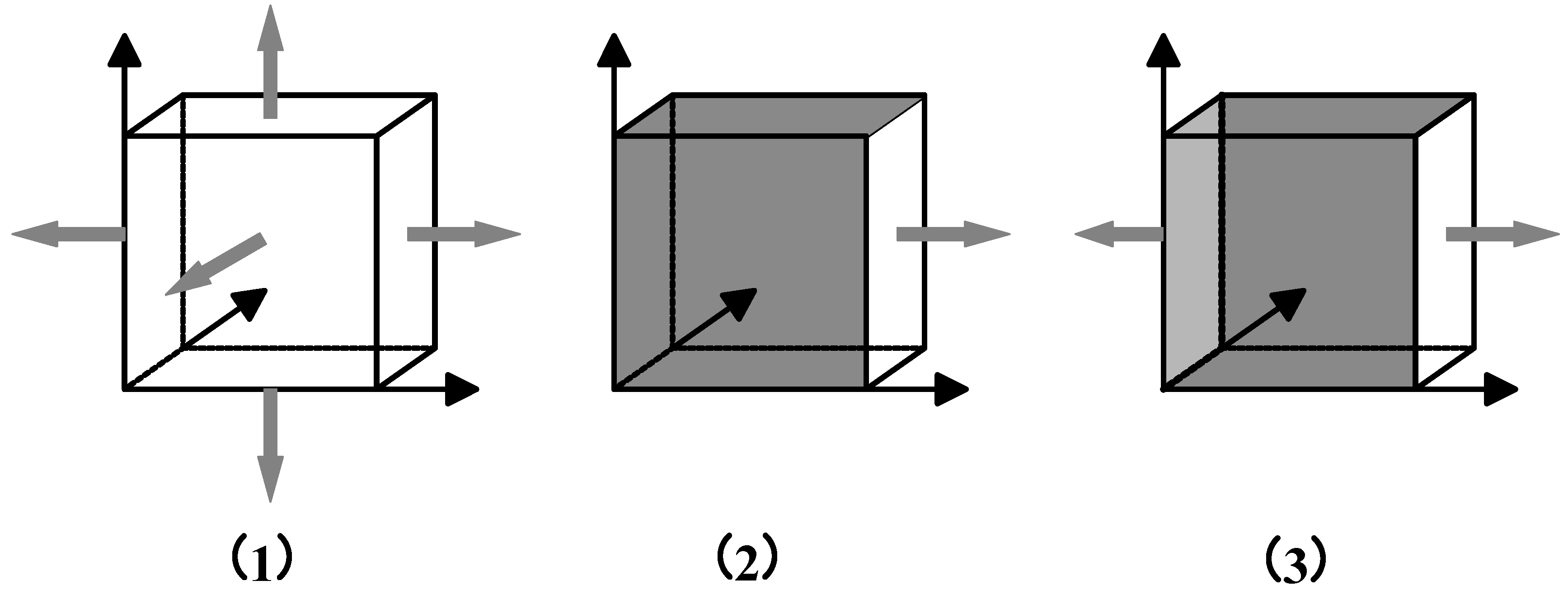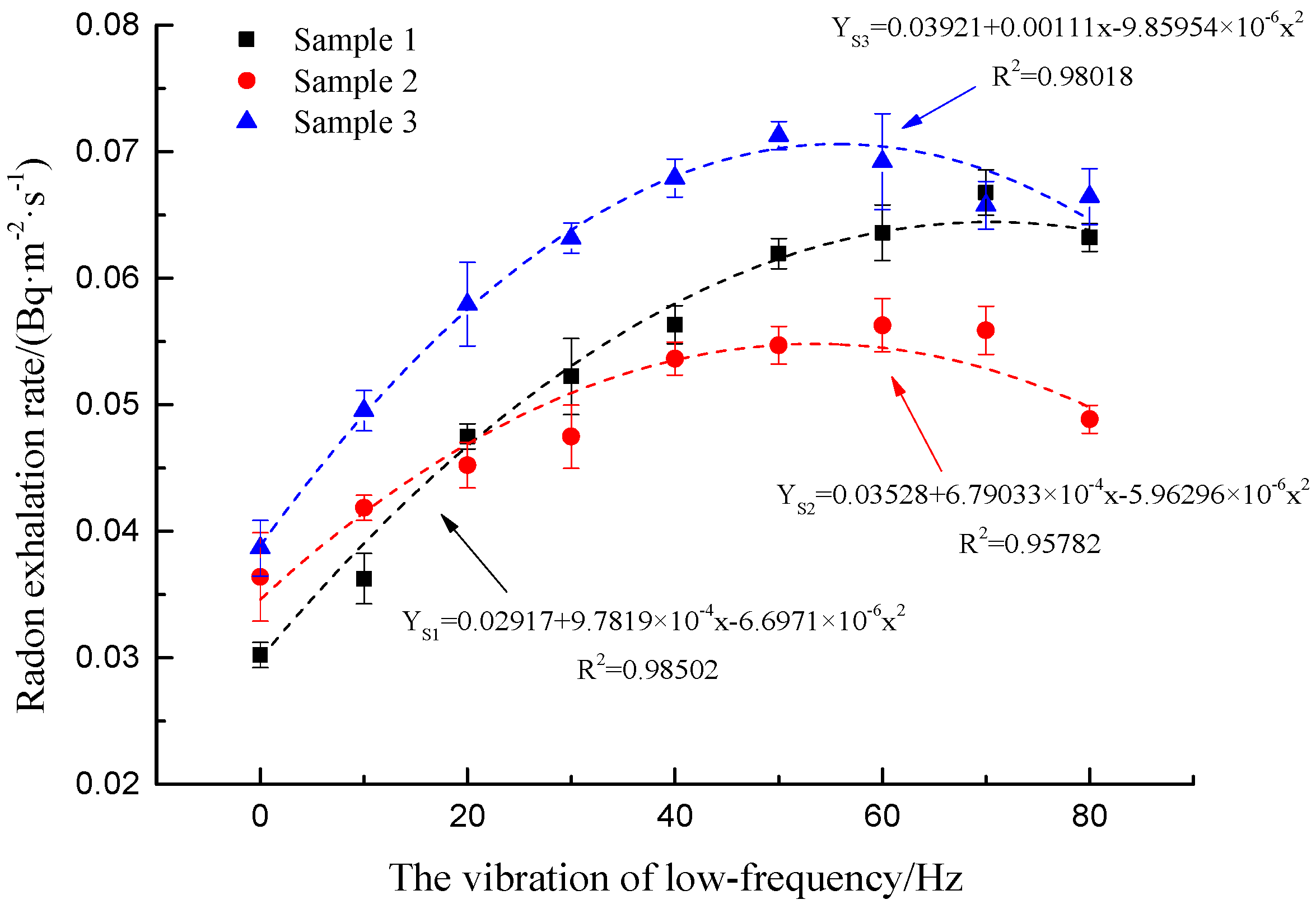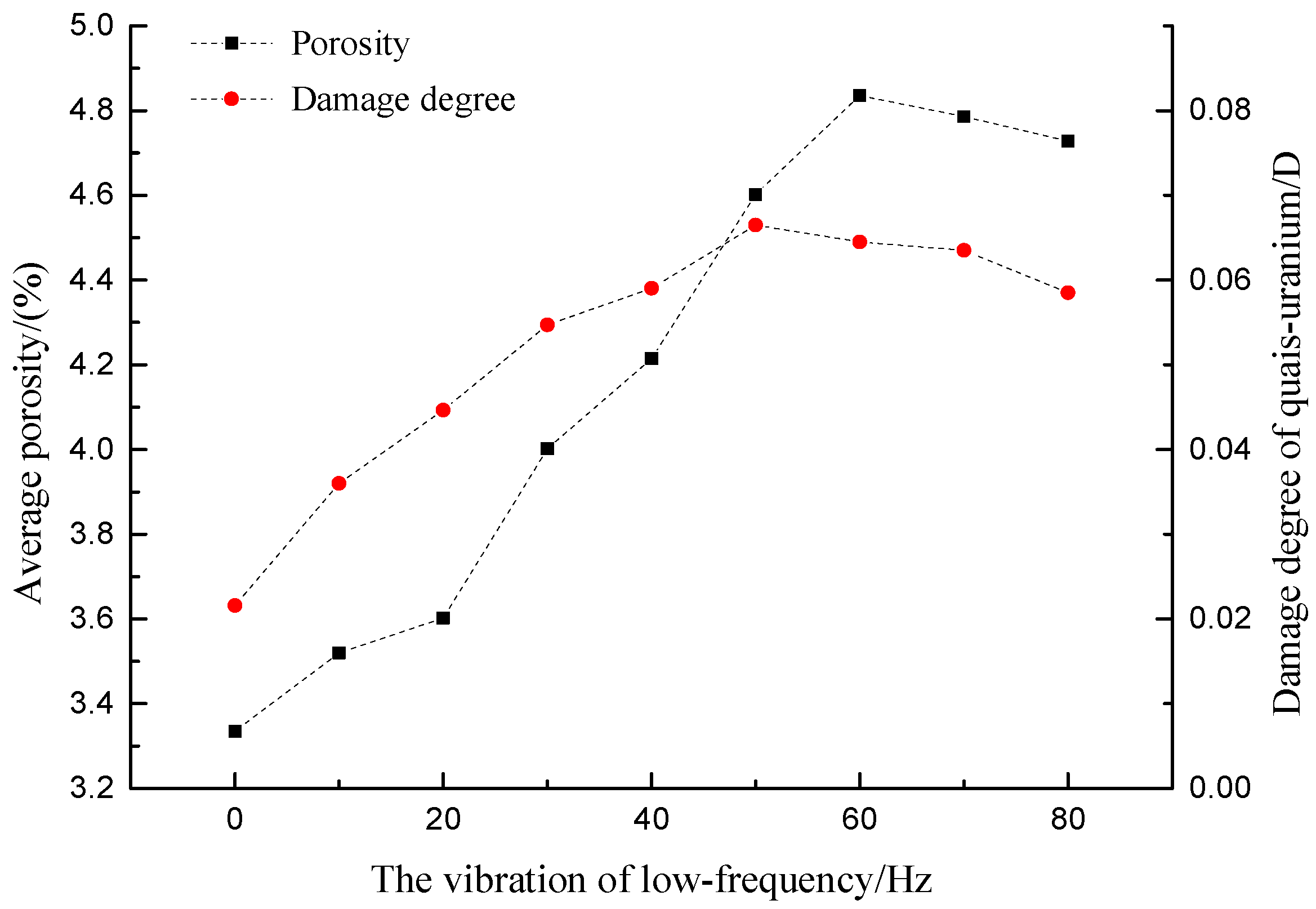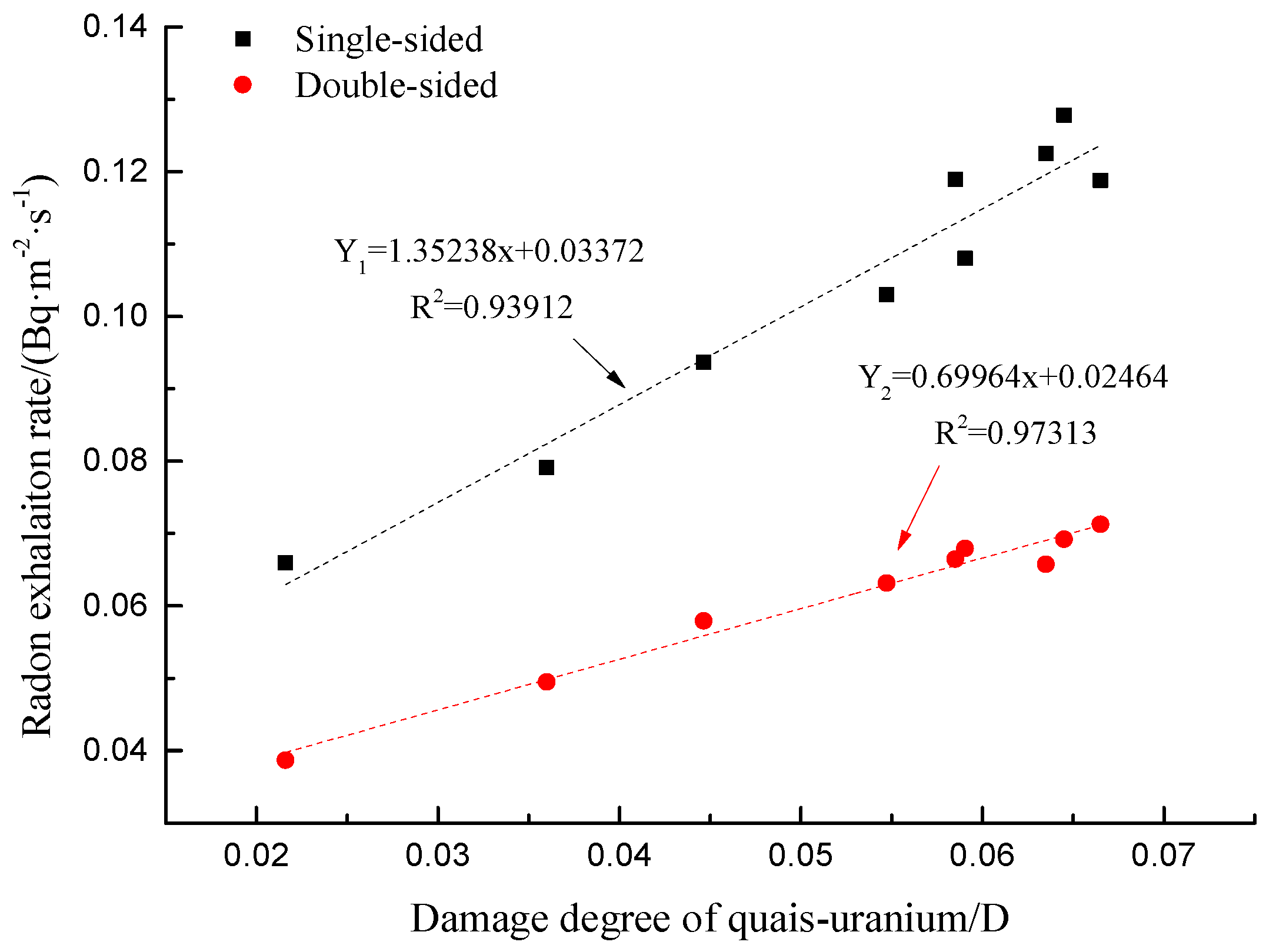Laboratory Experimental Laws for the Radon Exhalation of Similar Uranium Samples with Low-Frequency Vibrations
Abstract
:1. Introduction
2. Theory and Materials
2.1. The Radon Exhalation
2.2. The Porosity and the Damage Degree
2.3. Similar Samples
2.4. Trial Procedures
- (1)
- Check the tightness of the device and commission the system.
- (2)
- The temperature of the radon-collecting space is heated to 30 °C by starting the module. The space is purified for 30 min by turning on the purge function of RAD 7. According to the test plan, the wrapped single-sided exposed or double-sided exposed sample is installed on the fixed device and put into the radon exhalation tank.
- (3)
- The vibration frequency of the exciter is set according to the plan. Every test group is set for 200 pieces of data, of which each piece of data is obtained after 5 min by starting the RAD 7 to record. At the end of the experiment, the samples were taken out and the ambient temperature, humidity and atmospheric pressure were measured in real time, and the corresponding test data were recorded at the same time.
- (4)
- The change of the exciting force is monitored by using the piezoelectric sensors. First, the test sample is divided into four detection areas using the fluorescence pen, then the two sensors of the non-metallic ultrasonic testing device are pressed onto the two sides of the sample respectively by using a special adhesive, each test time is 30 s, and the data are recorded after the test. The damage degree of the rock is tested and calculated after the test by using a non-metallic ultrasonic testing device.
3. Results
3.1. Similar Samples
3.2. Radon Concentration and Time
4. Analysis and Discussion
4.1. Radon Exhalation and Frequency
4.2. Damage Degree and Porosity
5. Conclusions
Author Contributions
Funding
Acknowledgments
Conflicts of Interest
References
- Lian, B.G.; Liao, H.L.; Jin, H. The Hazards of Radon and its Precautions during the Underground Engineering. Chin. J. Radiol. Health 2014, 23, 143–144, 147. (In Chinese) [Google Scholar]
- Chauhan, P.; Kumar, A. A Comparative Study of Indoor Radon Contributed by Diffusive and Advective Transport through Intact Concrete. Phys. Procedia 2015, 80, 109–112. [Google Scholar] [CrossRef]
- Dutta, P.K.; Naskar, M.K.; Misa, O.P. Test of Strain Behavior Model with Radon Anomaly in Seismogenic Area: A Bayesian Melding Approach. Int. J. Geosci. 2012, 3, 126–132. [Google Scholar] [CrossRef]
- Zafrir, H.; Barbosa, S.M.; Malik, U. Differentiation between the Effect of Temperature and Pressure on Radon within the Subsurface Geological Media. Radiat. Meas. 2013, 49, 39–56. [Google Scholar] [CrossRef]
- Sakoda, A.; Ishimori, Y.; Hanamoto, K.; Kataoka, T.; Kawabe, A.; Yamaoka, K. Experimental and Modeling Studies of Grain Size and Moisture Content Effects on Radon Emanation. Radiat. Meas. 2010, 45, 204–210. [Google Scholar] [CrossRef]
- Saâdi, Z.; Gay, D.; Guillevic, J.; Améon, R. EOS7Rn—A New TOUGH2 Module for Simulating Radon Emanation and Transport in the Subsurface. Comput. Geosci. 2014, 65, 72–83. [Google Scholar] [CrossRef]
- Smetanová, I.; Holý, K.; Müllerová, M.; Polášková, A. The Effect of Meteorological Parameters on Radon Concentration in Borehole Air and Water. J. Radioanal. Nucl. Chem. 2010, 283, 101–109. [Google Scholar] [CrossRef]
- Zhang, J.; Tuo, X.; Li, Z. The Migration of Radon in Different Air Pressure Experimental Study and the Average Velocity Estimation. Energy Procedia 2013, 39, 443–453. [Google Scholar] [CrossRef]
- Jie, J.L. Experimental Study on Deterioration Mechanism of Rock under the Conditions of Freezing-Thawing Cycles in Cold Regions Based on NMR Technology. Ph.D. Thesis, Central South University, Changsha, China, 2012. [Google Scholar]
- Hao, H.; Wu, C.; Seah, C.C. Numerical Analysis of Blast-Induced Stress Waves in a Rock Mass with Anisotropic Continuum Damage Models Part 2: Stochastic Approach. Rock Mech. Rock Eng. 2002, 35, 95–108. [Google Scholar] [CrossRef]
- Nicolas, A.; Girault, F.; Schubnel, A.; Pill, E.; Passelegue, F.; Fortin, J. Radon Emanation from Brittle Fracturing in Granites under Upper Crustal Conditions. Geophysical Research Letters. 2015, 41, 5436–5443. [Google Scholar] [CrossRef]
- Yin, L.B. Research on the Blast Vibration in an Underground Uranium-mine Based on Ls-Dyna. Master Thesis, Jiangxi University of Science and Technology, Ganzhou, China, 2015. (In Chinese). [Google Scholar]
- Zhang, D.S.; Zhang, W.; Ma, L.Q.; Wang, X.F.; Fan, G.W. Developments and Prospects of Detecting Mining-Indued Fracture in Overlying Strata by Radon. J. China Univ. Min. Technol. 2016, 45, 1082–1097. (In Chinese) [Google Scholar]
- Yan, R.; Jiang, C.S.; Zhang, L.P. Study on Critical Slowing Down Phenomenon of Radon Concentrations in Water before the Wenchuan Ms 8.0 Earthquake Chinese. J. Geophys. 2011, 54, 1817–1826. (In Chinese) [Google Scholar]
- Cai, S.W. Computer Simulation of Natural Frequency of Sheare. Coal Mine Mach. 2006, 27, 110–111. (In Chinese) [Google Scholar]
- The National Standard of People’s Republic of China. Seismic Ground Motion Parameters Zonation Map of China, GB 18306-2015; Standard Press of China: Beijing, China, 2015.
- The Nuclear Industry Standard of People’s Republic of China. Safety Requirements for Decommissioning of Nuclear Facilities, GB/T19597-2004; Standard Press of China: Beijing, China, 2004. [Google Scholar]
- Külahci, F.; Inceöz, M.; Doğru, M.; Aksoy, E.; Baykara, O. Artificial Neural Network Model for Earthquake Prediction with Radon Monitoring. Appl. Radiat. Isot. Incl. Data Instrum. Methods Use Agric. Ind. Med. 2009, 67, 212–219. [Google Scholar] [CrossRef] [PubMed]
- Mollo, S.; Tuccimei, P.; Heap, M.J.; Vinciguerra, S.; Soligo, M.; Castelluccio, M.; Scarlato, P.; Dingwell, D.B. Increase in Radon Emission Due to Rock Failure: An Experimental Study. Geophys. Res. Lett. 2011, 38, 130–137. [Google Scholar] [CrossRef]
- Tan, K.X.; Wang, Q.L.; Liu, Z.H.; Hu, E.M. Nonlinear Dynamics of Flow-Reaction Coupling in Porous Media and Application to In Situ Leaching Uranium Mining. Int. J. Mod. Phys. B 2004, 18, 2663–2668. [Google Scholar] [CrossRef]
- Schild, M.; Siegesmund, S.; Vollbrecht, A.; Mazurek, M. Characterization of granite matrix porosity and pore-space geometry by In Situ, and laboratory methods. Geophys. J. R. Astron. Soc. 2001, 146, 111–125. [Google Scholar] [CrossRef] [Green Version]
- Dong, J.Y.; Yang, J.H.; Yang, G.X.; Wu, F.Q.; Liu, H.S. Research on Similar Material Proportioning test of Model Test Based on Orthogonal Design. J. China Coal Soc. 2012, 37, 44–49. [Google Scholar]
- Zuo, B.C.; Chen, C.X.; Liu, C.H.; Shen, Q.; Xiao, G.F.; Liu, X.W. Research on Similar Material of Slope Simulation Experiment. Rock Soil Mech. 2004, 25, 1805–1808. [Google Scholar]
- Li, S.; Feng, X.; Li, L.; Li, G. Research and Development of a New Similar for Solid-Fluid Coupling and its Application. Chin. J. Rock Mech. Eng. 2010, 29, 281–288. [Google Scholar]
- Zhao, K.; Jin, J.F.; Wang, X.J.; Zhao, K. Study on rock damage and acoustic emission based on ultrasonic velocity test of rock specimen under uniaxial compression. Rock Soil Mech. 2007, 28, 2105–2109. [Google Scholar]
- Yan, C.B. Blasting Damage Cumulative Effect of Rock Mass Based on Sound Velocity Variation. Rock Soil Mech. 2010, 31, 187–192. [Google Scholar]
- Yilmaz, O.; Unlu, T. Three dimensional numerical rock damage analysis under blasting load. Tunn. Undergr. Space Technol. Incorp. Trenchless Technol. Res. 2013, 38, 266–278. [Google Scholar] [CrossRef]
- Cao, W.; Zhao, H.; Zhang, L.; Zhang, Y. Damage statistical softening constitutive model for rock considering effect of damage threshold and its parameters determination method. Chin. J. Rock Mech. Eng. 2008, 27, 1148–1154. [Google Scholar]












| Mining Operation Factor | Medium-Length Hole Blasting | Shallow Hole Blasting | Seismic Wavelet | Drilling Jumbo | Shovel Car | ||
|---|---|---|---|---|---|---|---|
| Wenchuan Quake Wave | Darui Synthetic Wave | Kobe Seismic | |||||
| Vibration frequency (Hz) | 10~60 | 9~48 | 5~27 | 4~12 | 1~25 | 10~50 | 50 |
| Test Plan | Water Cement Ratio | Sand-Binder Ratio | Micro Silicon Powder | Iron Powder |
|---|---|---|---|---|
| Sample 1 | 0.28 | 1.00 | 0.09 | 0.20 |
| Sample 2 | 0.28 | 1.20 | 0.12 | 0.25 |
| Sample 3 | 0.30 | 1.20 | 0.06 | 0.20 |
| Test Plan | Compressive Strength/MPa | Tensile Strength (MPa) | Particle Density/(g·cm−3) | Cohesion (MPa) | Internal Friction Angle (°) | Dry Density/(g·cm−3) | Radium Content (Bq·g−1) | Percentage of Uranium Mass (%) |
|---|---|---|---|---|---|---|---|---|
| Sample 1 | 62.9 | 3.67 | 2.42 | 16.03 | 51.36 | 2.301 | 1.57 | 0.0071 |
| Sample 2 | 71.2 | 4.12 | 2.49 | 15.91 | 50.44 | 2.365 | 1.72 | 0.0068 |
| Sample 3 | 53.4 | 3.53 | 2.46 | 14.55 | 54.21 | 2.290 | 1.78 | 0.0085 |
| The original sample of granite | 206.86 | 13.23 | 2.62 | 49.52 | 48.60 | 2.415 | 0.073 | 0.03 |
| Test Plan | Cp | CRc | CPt | CC | Cσ |
|---|---|---|---|---|---|
| Sample 1 | 1.09 | 4.93 | 4.45 | 3.30 | 1.16 |
| Sample 2 | 1.11 | 3.17 | 4.50 | 3.55 | 0.94 |
| Sample 3 | 1.08 | 4.07 | 3.93 | 3.57 | 0.94 |
© 2018 by the authors. Licensee MDPI, Basel, Switzerland. This article is an open access article distributed under the terms and conditions of the Creative Commons Attribution (CC BY) license (http://creativecommons.org/licenses/by/4.0/).
Share and Cite
Cai, Z.-q.; Li, X.-y.; Lei, B.; Yuan, J.-f.; Hong, C.-s.; Wang, H. Laboratory Experimental Laws for the Radon Exhalation of Similar Uranium Samples with Low-Frequency Vibrations. Sustainability 2018, 10, 2937. https://doi.org/10.3390/su10082937
Cai Z-q, Li X-y, Lei B, Yuan J-f, Hong C-s, Wang H. Laboratory Experimental Laws for the Radon Exhalation of Similar Uranium Samples with Low-Frequency Vibrations. Sustainability. 2018; 10(8):2937. https://doi.org/10.3390/su10082937
Chicago/Turabian StyleCai, Zi-qi, Xiang-yang Li, Bo Lei, Jing-fan Yuan, Chang-shou Hong, and Hong Wang. 2018. "Laboratory Experimental Laws for the Radon Exhalation of Similar Uranium Samples with Low-Frequency Vibrations" Sustainability 10, no. 8: 2937. https://doi.org/10.3390/su10082937
APA StyleCai, Z. -q., Li, X. -y., Lei, B., Yuan, J. -f., Hong, C. -s., & Wang, H. (2018). Laboratory Experimental Laws for the Radon Exhalation of Similar Uranium Samples with Low-Frequency Vibrations. Sustainability, 10(8), 2937. https://doi.org/10.3390/su10082937




